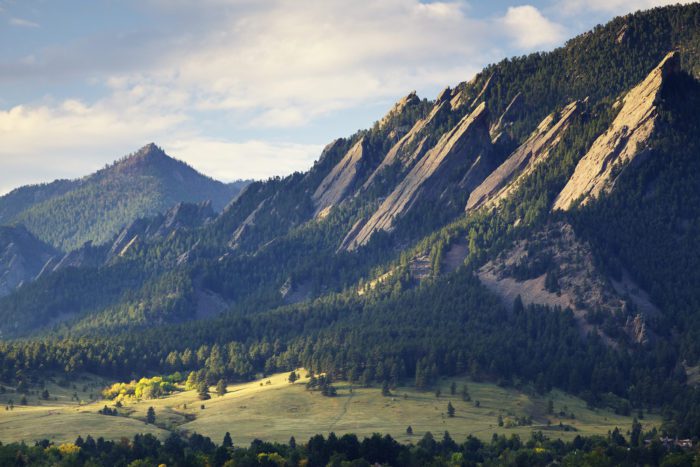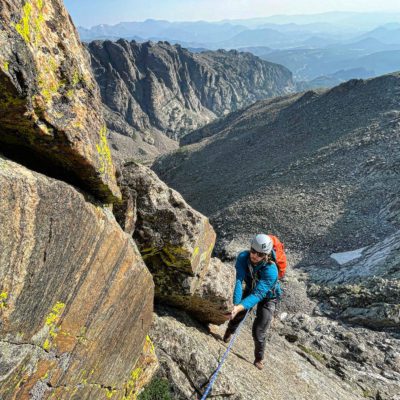Climbing in Colorado’s Iconic Climbing Mecca – The Flatirons
January 18, 2022 | Posted in: JHMG
The backdrop to Boulder, the Flatirons are a majestic piece of the Rocky Mountains that have become synonymous with the culture of the city. Just blocks from Pearl Street and The University of Colorado, these five iconic slanted rock faces epitomize the Boulder community. Climbers love them for their quick access and thoughtless descent, trail enthusiasts fuel their day with an early morning run through their maze of trails to gain a view of their town below, and sightseers view them from afar while visiting Chautauqua Park. Their slanted summits make you wonder how they formed?
How did the Flatirons Form?
The Flatirons formed by a collision of tectonic plates. 300 million years ago, Boulder sat below sea level. After approximately 230 million years, the city slowly began to rise from being fully submerged, to sitting as a beach, and later as a shallow sea. At 65 million years ago, an oceanic plate converged with the North American continental plate, causing the oceanic plate to sink deep into the earth. Due to the oceanic plate’s angle of subduction, the sideways and downward movement of the edge of one tectonic plate into another became shallower, forming the Rocky Mountains. Like a drawbridge opening for a ship below, what once lay flat with layers of sediment had hardened into rock and began to tilt upwards due to its underlying pressure. Lifted and angled, the Flatirons now extend to 7,132 feet in elevation.
Rock Climbing the Flatirons
Climbing in the Flatirons dates back a century. To climb a Flatiron, be prepared to hike to the base of the climb from Chautauqua Park, ascend over 1,000 vertical feet by rock climbing, take in the view and glorious feeling of being at the top of the world (or Boulder), and descend by hiking from the top of the climb and back to Chautauqua Park. Car to car, our trips last approximately 8 hours.
The Flatirons host a variety of styles of climbing, from offering some of the best beginner multi-pitch climbing in the United States, to obscure boulder problems and slab climbs scattered throughout the woods, to lofty technical summits and old school classics. A general rule of thumb is that the eastern facing routes are lower angle and offer the easiest climbing, while the north, west and south aspects tend to steepen, increasing their difficulty. While there are dozens of formations scattered about, there are 5 main Flatirons that run north to south along the easter slope of Green Mountain. These are what most people refer to when they speak of The Flatirons.
The Mountain Guides Colorado offers Private Climbs in the Flatirons, meaning our guides will work with you to come up with an itinerary based on your skills and agenda and deliver personalized coaching and instruction to help you achieve your climbing goals.
Below is more detail on what adventures may await you when climbing with The Mountain Guides in the Flatirons.
First Flatiron
The first Flatiron is the most recognizable and most visited of its siblings. One of the larger Flatirons, the first Flatiron is known for the Direct East Face 5.6R route. Over 1,000 feet long with up to 10 pitches of climbing, the biggest challenge of the climb is right at the beginning. This is a traditional (“trad”) climb, meaning there are few fixed bolts requiring the leader to place protection along the way.
Second Flatiron
The second Flatiron rests between the larger first and third Flatirons. Less popular than its neighbors, the second Flatiron is known for “ Freeway”, a popular 5.0 that experienced climbers tend to solo (or climb without ropes).
Third Flatiron
We’ll let you in on a little secret. The Standard East Face, 5.4, on the third Flatiron is quite possibly the greatest beginner climb in the world. This long, mellow and scenic climb scales up 8 pitches of appetizing red sandstone. The third Flatiron is also known for its history. In 1949, a fifty-foot letter “C” was illegally painted on the rock and although the letters have been painted over to match the color of the rock, a keen eye can still spot the marking.
Forth Flatiron
The forth Flatiron is the largest, composed of three slabs separated by two gullies. The first section begins right off the Royal Arch Trail (although this spot is not obvious), the second section sweeps up into several summits (the most northern of which is Green Mountain Pinnacle), and the third section merges with the SE ridge of Green Mountain. The summit of the third section is the highest of the five Flatirons, and it is also the easiest to down climb off of.
Fifth Flatiron
The fifth Flatiron is the southernmost of the numbered Flatirons. While the climbing on the east face is technically quite similar, it is far less frequented.
Interested in Climbing in the Flatirons?
TheMountain Guides – Colorado offers year-round, single day trips to climb in the Flatirons. As the Flatirons have a number of different routes, we offer a variety of medium-length, traditionally protected multi-pitch climbs and choose routes based on your abilities and goals. We also require prior multi-pitch climbing experience or instruction to participate in our group climbs. Our private climbs are the best option for people looking to get the most out of the day with an itinerary personalized to your goals and skills.






